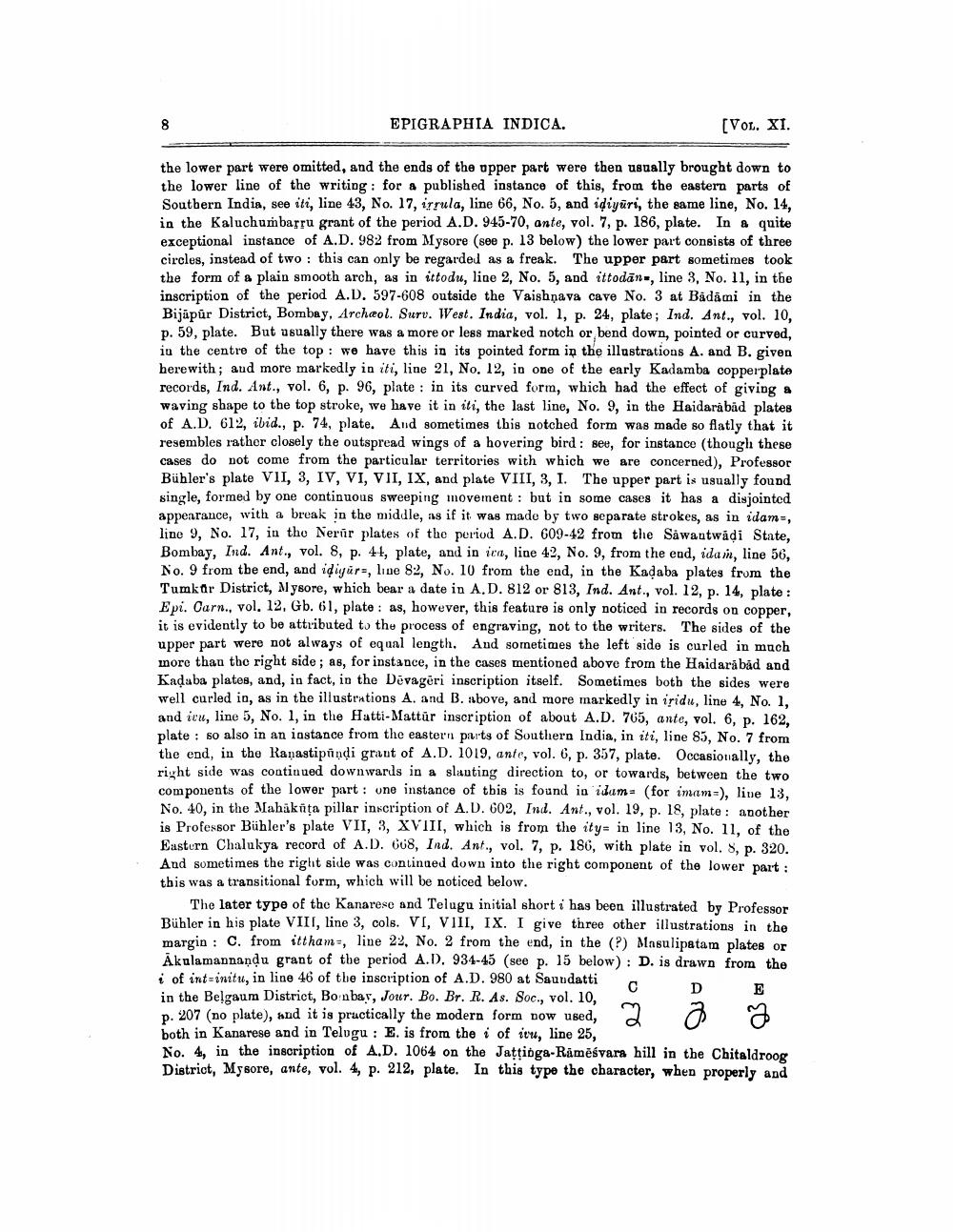________________
8
EPIGRAPHIA INDICA.
[VOL. XI.
:
the lower part were omitted, and the ends of the upper part were then usually brought down to the lower line of the writing for a published instance of this, from the eastern parts of Southern India, see iti, line 43, No. 17, irrula, line 66, No. 5, and iḍiyuri, the same line, No. 14, in the Kaluchumbarru grant of the period A.D. 945-70, ante, vol. 7, p. 186, plate. In a quite exceptional instance of A.D. 982 from Mysore (see p. 13 below) the lower part consists of three circles, instead of two: this can only be regarded as a freak. The upper part sometimes took the form of a plain smooth arch, as in ittodu, line 2, No. 5, and ittodan, line 3, No. 11, in the inscription of the period A.D. 597-608 outside the Vaishnava cave No. 3 at Badami in the Bijapur District, Bombay, Archeol. Surv. West. India, vol. 1, p. 24, plate; Ind. Ant., vol. 10, p. 59, plate. But usually there was a more or less marked notch or bend down, pointed or curved, in the centre of the top: we have this in its pointed form in the illustrations A. and B. given herewith; and more markedly in iti, line 21, No. 12, in one of the early Kadamba copperplate records, Ind. Ant., vol. 6, p. 96, plate in its curved form, which had the effect of giving a waving shape to the top stroke, we have it in iti, the last line, No. 9, in the Haidarabad plates of A.D. 612, ibid., p. 74, plate. And sometimes this notched form was made so flatly that it resembles rather closely the outspread wings of a hovering bird: see, for instance (though these cases do not come from the particular territories with which we are concerned), Professor Bühler's plate VII, 3, IV, VI, VII, IX, and plate VIII, 3, I. The upper part is usually found single, formed by one continuous sweeping movement: but in some cases it has a disjointed appearance, with a break in the middle, as if it was made by two separate strokes, as in idam, line 9, No. 17, in the Nerur plates of the period A.D. 609-42 from the Sawantwadi State, Bombay, Ind. Ant., vol. 8, p. 44, plate, and in ica, line 42, No. 9, from the end, idam, line 56, No. 9 from the end, and iḍigur, line 82, No. 10 from the end, in the Kadaba plates from the Tumkar District, Mysore, which bear a date in A. D. 812 or 813, Ind. Ant., vol. 12, p. 14, plate: Epi. Carn., vol. 12. Gb. 61, plate: as, however, this feature is only noticed in records on copper, it is evidently to be attributed to the process of engraving, not to the writers. The sides of the upper part were not always of equal length. And sometimes the left side is curled in much more than the right side; as, for instance, in the cases mentioned above from the Haidarabad and Kadaba plates, and, in fact, in the Devageri inscription itself. Sometimes both the sides were well curled in, as in the illustrations A. and B. above, and more markedly in iridu, line 4, No. 1, and ieu, line 5, No. 1, in the Hatti-Mattür inscription of about A.D. 765, ante, vol. 6, p. 162, plate so also in an instance from the eastern parts of Southern India, in iti, line 85, No. 7 from the end, in the Ranastipindi grant of A.D. 1019, ante, vol. 6, p. 357, plate. Occasionally, the right side was continued downwards in a slanting direction to, or towards, between the two components of the lower part one instance of this is found in idam (for imam), line 13, No. 40, in the Mahäkita pillar inscription of A.D. 602, Ind. Ant., vol. 19, p. 18, plate: another is Professor Bühler's plate VII, 3, XVIII, which is from the ity in line 13, No. 11, of the Eastern Chalukya record of A.D. 668, Ind. Ant., vol. 7, p. 186, with plate in vol. 8, p. 320. And sometimes the right side was continued down into the right component of the lower part: this was a transitional form, which will be noticed below.
:
The later type of the Kanarese and Telugu initial short i has been illustrated by Professor Bühler in his plate VIII, line 3, cols. VI, VIII, IX. I give three other illustrations in the margin C. from ittham, line 22, No. 2 from the end, in the (?) Masulipatam plates or Akulamannaṇḍu grant of the period A.D. 934-45 (see p. 15 below): D. is drawn from the i of int initu, in line 46 of the inscription of A.D. 980 at Saundatti in the Belgaum District, Bombay, Jour. Bo. Br. R. As. Soc., vol. 10, p. 207 (no plate), and it is practically the modern form now used, both in Kanarese and in Telugu: E. is from the i of itu, line 25, No. 4, in the inscription of A.D. 1064 on the Jaṭṭinga-Raměsvara hill in the Chitaldroog District, Mysore, ante, vol. 4, p. 212, plate. In this type the character, when properly and
C
E
D
a




